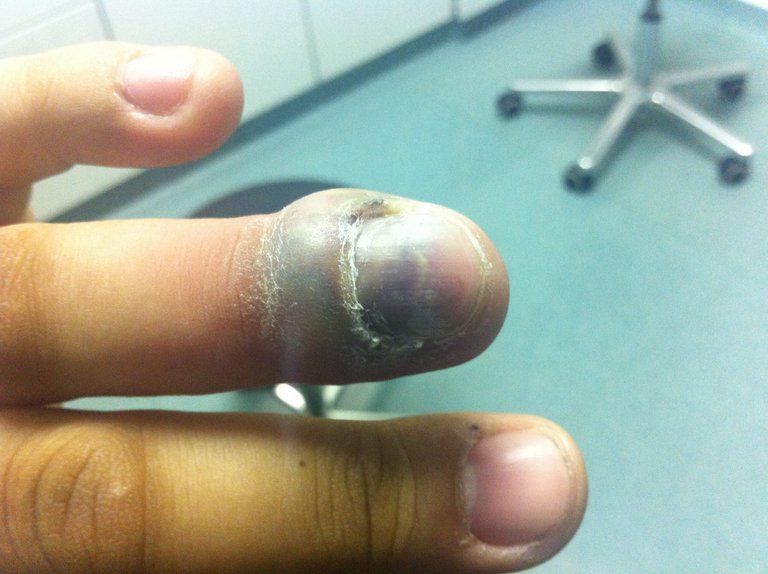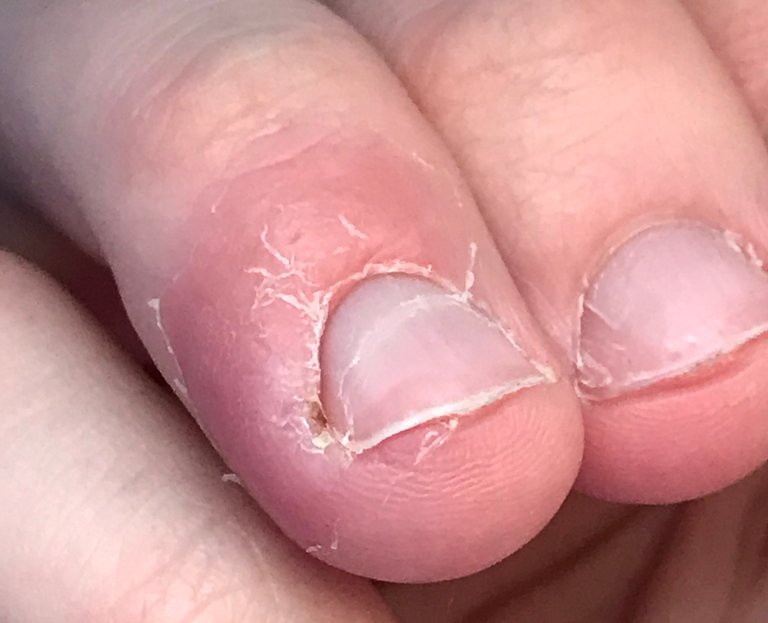Paronychia Infection, a Serious Type of Nail Infection.
I am highly particular about how my nails look, taking a picture showing my nail and it looks unkempt gets at me differently, there is a lot of confidence linked to having a nail infection is a bacterial or fungi infection, bacteria enter the skin through routes of cuts in the cuticle and the nail fold which is the skin around the nail. So many people have picked up the habit of chewing their nails from childhood and it grows into a bad habit that has now become very difficult to stop, one of the side effects of chewing nails is Paronychia.

Image Source
Most cases of nail infection get better with simple antibiotics, as most cases of paronychia would not usually result in a serious health problem, but some cases of infection last for a very long time and come back even after successful treatment.
Paronychia is a nail infection that may result from irritation, trauma, or infection, it can affect both toenails and fingernails causing an infection, in case you are wondering what a nail fold is, it is that point where the skin and the nail come together. Doctors could also refer to paronychia as candidal paronychias, in which is, there is mostly a disruption in the barrier between the nail fold and the nail plate resulting from the infection of a yeast called candida albicans.
An ingrown toenail is another form of nail infection, which is attributed to the nail plate growing into the surrounding skin, causing infection and inflammation, creating discomfort and pain especially when it is left untreated for a long time. When the nail breaks the skin, it often creates infection including paronychia. Ingrown toenails may happen as a result of; foot injury, cutting nails inappropriately, poor foot hygiene, shoe sizes that are too small and create pressures on the corners of the toenail, and medications affecting the skin. Some symptoms of paronychia resemble some skin infections closely, the symptoms include; nail hardening, separating the nail from the nailbed, nail hardening, pus-filled abscesses, tenderness, and swelling happening around the nails.

Image Source
The occurrence of paronychia is attached to the skin around the nails getting damaged, giving room for the entrance of germs, what makes the skin damage around the nail region is when there are; manicures, chewing or biting of the nails, picking at nails, having ingrown nails, excessively exposing the hands to moisture including sucking the finger excessively. Paronychia is a common nail condition and regardless of age or gender, anyone can get a nail infection, but it is more common among people who do these things;
- Those who bite their nails or cuticles.
- Are exposed to irritants.
- Have some type of skin condition.
- Constantly work with water.
There are two types of paronychia, the two have similar signs and symptoms including;
Acute paronychia, the symptoms of acute paronychia appear for a few hours or for a few days, this infection only exists in the nail fold and doesn't get deep into the finger or the toe. The symptoms go away on their own without treatment and last for less than six (6) weeks.
Chronic paronychia: In chronic paronychia, the symptoms will grow more slowly than in acute paronychia, and they will last for six weeks or even longer. Several toes or fingers can get infected at the same time. Most times, it doesn't even get better or it just keeps coming back.
With a simple physical examination, a doctor can diagnose paronychia, but the doctor may also want to send some fluid or pus samples to the laboratory to help them identify if the infection is caused by bacteria or fungi. The most appropriate way to avoid paronychia is by taking appropriate care of your nails, do these simple things;
- Make use of clean nail clippers or scissors to trim your nails.
- Do not cut your nails too short.
- Do not bite or pick your nails.
- Make sure that there is no injury to your nails or fingertips.
- Scraping or trimming your cuticles can cause injury to the skin.
In the case of chronic paronychia, you can avoid that by ensuring that your hands are free from chemicals and are always dry, you should also learn to put on gloves when working with water or harsh chemicals, constantly change socks to at least on a daily basis and try not to put on the same shoes twice in a row as this allows the shoe dry up completely.
Treating paronychia is highly dependent on the severity of the infection, with acute paronychia, soaking the infected nail in warm water up to 3-4 times a day can reduce pain and swelling and could heal up in a few days. If it happens that the infection is painful and doesn't get better with the home care strategies applied, you should instantly see a doctor. If you have an abscess, the doctor would have to drain it out, numb the area, separate the skin from the base or the sides of the nail and then drain out the pus. There are even some home remedies that can be used to treat paronychia, soaking the infected area in warm water for about 15 minutes a few times a day, then drying the area afterward would help. Soaking the cuticle and nailbed helps to drain pus from under the skin.
Treating paronychia sounds really simple and stress-free but in some cases can cause permanent damage to the nail, if the patient also has diabetes, there is a strong chance that paronychia can spread deeper into bones, tissues, or even into the bloodstream and other body parts. In extreme cases of deep infection, paronychia can lead to the loss of a limb, a toe, or a finger. Make sure to contact your doctor if you begin to;
- Have fever or chills.
- Joint or muscle pains.
- Red streaks appear on your skin.
Conclusion.
Paronychia is a skin infection affecting the fingernail or the toenail often caused by chewing or biting the fingernails, the symptoms felt with paronychia include swelling, pain, and discomfort. It can be an acute or chronic case that could either go away with simple home remedies or grow into a complex situation that requires constant treatment. Paying proper attention and care to the nails is a good strategy to prevent paronychia from happening.
References.
https://www.medicalnewstoday.com/articles/324059#summary
https://familydoctor.org/condition/paronychia/
https://kidshealth.org/en/parents/paronychia.html
https://www.ncbi.nlm.nih.gov/books/NBK544307/
https://www.healthline.com/health/how-to-make-a-vinegar-foot-soak
https://my.clevelandclinic.org/health/diseases/15327-nail-infection-paronychia
Thanks for your contribution to the STEMsocial community. Feel free to join us on discord to get to know the rest of us!
Please consider delegating to the @stemsocial account (85% of the curation rewards are returned).
Thanks for including @stemsocial as a beneficiary, which gives you stronger support.